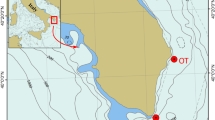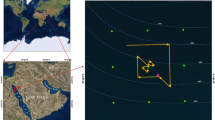Abstract
CRACKS running through raised Pleistocenic coral reefs form a common environment around the tropical Indian and Pacific Oceans. The cracks can be reached only when they have an opening to the surface of the dry raised reef, and therefore the biota found in the open cracks is a mixture of light-avoiding subterranean species and of shadow-loving marine species. Near the southern tip of the Sinai Peninsula, Cape Ras Muhammad (Fig. 1), an open crack of about 40 m length and 0.20–1.5 m width and about 150 m inland, was discovered in October 1971 (Fig. 2). It is possible, with difficulty, to descend into the crack and dive to depths of over 14 m.
This is a preview of subscription content, access via your institution
Access options
Subscribe to this journal
Receive 51 print issues and online access
$199.00 per year
only $3.90 per issue
Buy this article
- Purchase on Springer Link
- Instant access to full article PDF
Prices may be subject to local taxes which are calculated during checkout
Similar content being viewed by others
References
Holthuis, L. B., Zool. Mededel., 38, 16, 261 (1963).
Oren, O. H., Nature, 194, 1134 (1962).
Por, F. D., Sea Fish. Res. Sta. Haifa Bull., 49, 32 (1968).
Tsurnamal, M., and Por, F. D., Intern. Journ. Speleology, 3 (3+4), 219 (1968).
Author information
Authors and Affiliations
Rights and permissions
About this article
Cite this article
POR, F., TSURNAMAL, M. Ecology of the Ras Muhammad Crack in Sinai. Nature 241, 43–44 (1973). https://doi.org/10.1038/241043b0
Issue Date:
DOI: https://doi.org/10.1038/241043b0
This article is cited by
-
Hydro/Engineering Geophysical Parameters and Design Response Spectrum for Sustainable Development in Ras Muhammed National Park, Sinai
Pure and Applied Geophysics (2016)
-
Ecology of the metahaline pool of Di Zahav, Gulf of Elat, with notes on the siphonocladacea and the typology of near-shore marine pools
Marine Biology (1974)
Comments
By submitting a comment you agree to abide by our Terms and Community Guidelines. If you find something abusive or that does not comply with our terms or guidelines please flag it as inappropriate.



